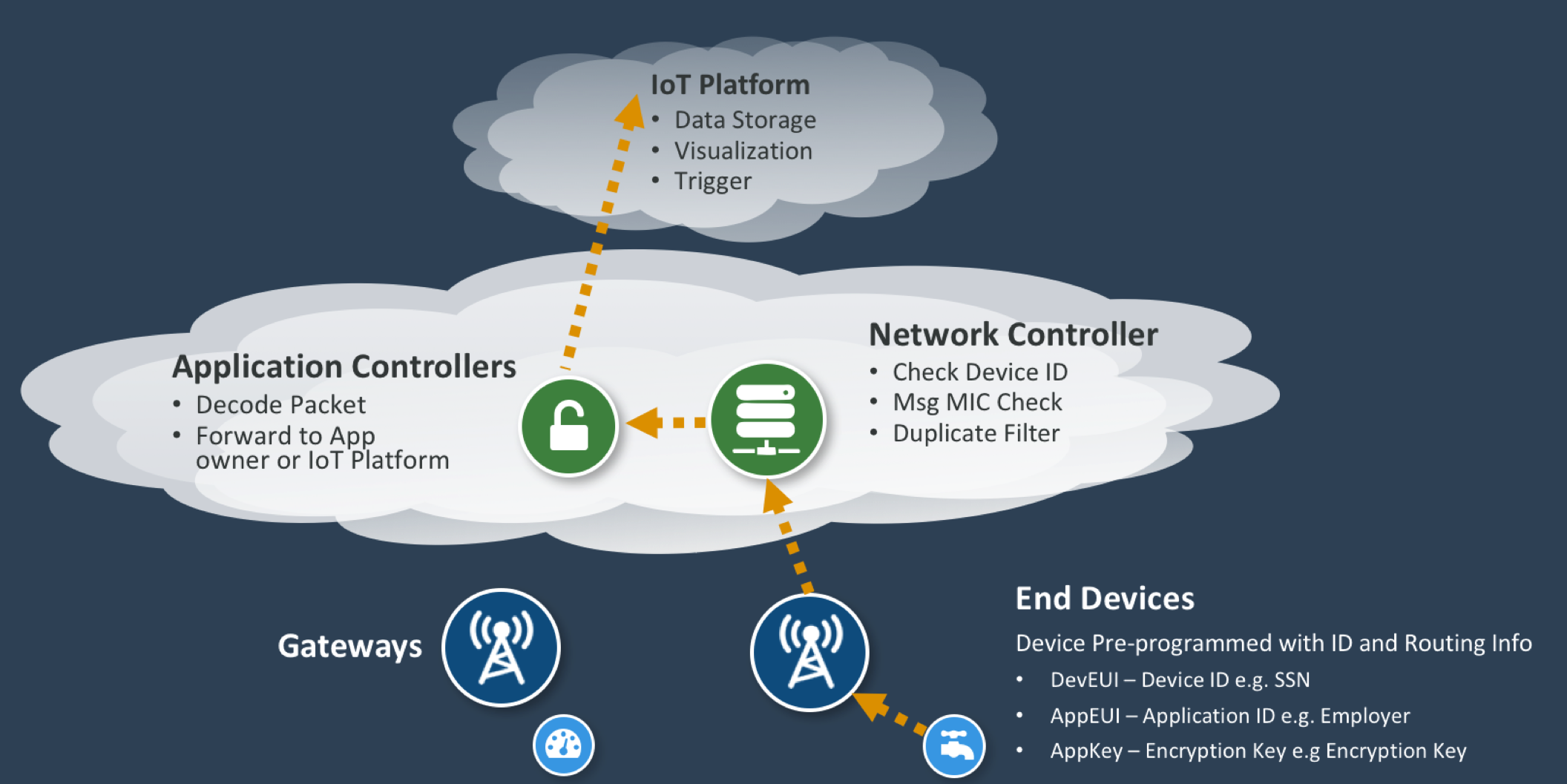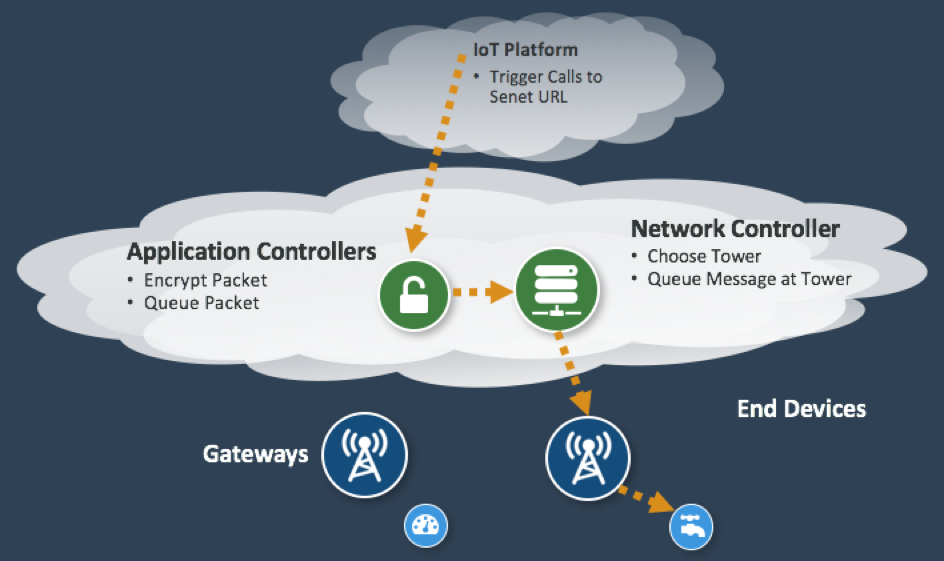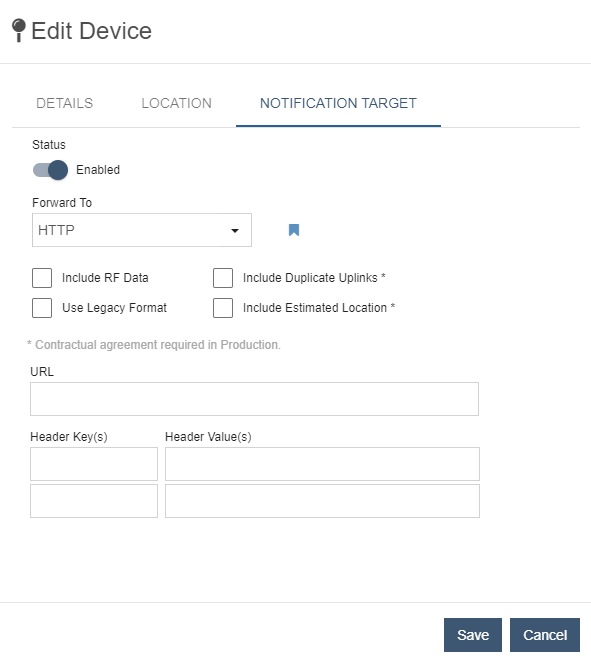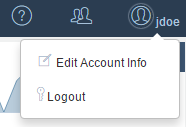API Reference
Senet offers a variety of methods to stream device messages transmitted over the Senet Network.
Overview
Uplink Messages
Devices transmit an uplink message to one or more gateways that relays the message to the network server. The network server forwards the message to an IoT platform.

Downlink Messages
IoT platforms make calls to the network server. The network server sends each downlink message to a single gateway that transmits the message to a single device.

Notification Targets
Data streaming is setup by creating a Notification Target for a devices. The Notification Target configures the network server to stream device uplinks to a user specified destination or 3rd party IoT platform. In other words, uplink messages are forwarded as they are received by the Senet Network.
Configure a Notification Target:
-
Open the Edit Device window.
-
Table View: Select a row in the device table. Click on the edit button
 .
. -
Tile View: Click on the menu button
 . Click on the edit button
. Click on the edit button  .
. -
Device Details: Click on the edit button
 .
.

-
-
Click on the NOTIFICATION TARGET tab.

-
In the Forward To dropdown menu, choose a Notification Target type to display the required fields and options.
-
Complete the required fields and click Save.
Note
A firewall rule may need to be added to allow incoming uplink messages from the Senet Network.
Senet Source IP Addresses: 34.197.99.138 and 52.88.64.191
Supported Notification Targets
The Senet Network supports a variety of options to forward messages as they are received by the network. Options may be to forward messages to a private socket listener or a public subscription based analytics solution. By Default, only the packet with the best Signal to Noise Ratio (SNR) will be forwarded. To receive packets received by multiple gateways (Duplicate Packets) enable “Include Duplicate Uplinks” when setting up the notification target.
For a list of the supported notifications targets and configurations use the drop-down API menu above.
Consecutive Errors
Notification Targets that produce 10 consecutive errors when forwarding data will be disabled by the network server. This is to prevent excessive load on the target and on the network server. A short outage in network connectivity should not trigger the 10 consecutive error limit on most devices. However, if your device has a very short transmit interval, it may be possible to reach the 10 consecutive error limit in a very short period of time. If your Notification Target is disabled by the network server, review the Last Error message field in the device details. This error message will help you understand why the notifications are failing. If you believe the errors were caused by an interruption in service that has now been corrected, you can re-enable the Notification Target to restore message forwarding. If the error condition persists, the Notification Target will again be disabled when the error limit is reached.
Uplink API
The Senet Network receives payload data from devices via one or more gateways that receive the transmission. In addition to streaming the payload data (pdu), network information is also included. The data is formatted using JSON and contains the following default fields. Optional RF fields can also be added by enabling "Include RF Data" in the notification target.
The Senet Network supports the standard JSON object model where each object contains one-to-many key/values pairs. The JSON object is in the following format:
Note
Senet may add additional fields during future Portal updates. Please ensure that your Application will ignore any unknown fields and continue to parse the notification data.
{
"Key":"String Value",
"Key": Numeric Value
}
Fields
| FieldName | DataType | Category | Description |
|---|---|---|---|
| devEui | String | Default | 64-bit Extended Unique Identifier of the Device transmitting the message |
| gwEui | String | Default | 64-bit Extended Unique Identifier of the Base Station that received the message. Without Duplicates included this identifies Base Station that first relayed the message, though not necessarily the one preferred for downlink communication. |
| joinId | Number | Default | Incrementing Integer used to Identify the last join |
| pdu | String | Default | Protocol Data Unit or Customer Payload data |
| port | Number | Default | 0 indicates that the FRMPayload contains MAC commands only and 1..223 are application specific |
| seqno | Number | Default | Incrementing Integer used to Identify an uplink |
| txtime | String | Default | Time the message was received by the Network Server |
| channel | Number | RF Field | Frequency Channel of the transmission |
| datarate | Number | RF Field | Integer that maps to a spreading factor, bandwidth and bitrate |
| freq | Number | RF Field | Transmit Frequency in MHz |
| rssi | Number | RF Field | Received Signal Strength Indicator reported by receiving Gateway |
| snr | Number | RF Field | Average Signal to Noise Ratio reported by receiving Gateway |
| ismBand | String | RF Field | The ISMBand (US915,EU868,EU433,CN779,AU915,CN470, etc) reported by the receiving Gateway |
| maxPayload | Number | RF Field | Max Payload size in bytes that can be sent at the current datarate by this Device |
| appEui | String | Optional | The Application's IEEE EUI-64 identifier. |
| ack | Boolean | Optional | Flag indicating if the uplink was acknowledging the receipt of a downlink |
| ackDnMsgId | Number | Optional | When present, indicates that a Device has acknowledged a specific downlink message ID |
| devClass | String | Optional | LoRaWAN Class designation ("A", "B", "C") of the Device |
| devType | String | Optional | The type of the Device |
| dup* | Boolean | Optional | Flag indicating if the uplink was already forwarded because it was heard by multiple Gateways |
| estLat* | Number | Optional | Estimated latitude of the Device in decimal degrees |
| estLng* | Number | Optional | Estimated longitude of the Device in decimal degrees |
| cfgLat | Number | Optional | Configured latitude of the Device in decimal degrees |
| cfgLng | Number | Optional | Configured longitude of the Device in decimal degrees |
| tags | String | Optional | A comma separated list of tags configured on this device |
| metadata | String | Optional | The metadata value configured on this Device |
| devProfile | String | Optional | The name of the Profile applied to this Device |
| fwVersion | String | Optional | The firmware version of this Device |
| gwRxTime | String | Optional | Time the message was received by the Gateway |
* Requires contractual agreement in Production
Example with Payload Fields:
{
"ack":true,
"ackDnMsgId": 100000,
"devClass": "A" ,
"devEui":"FFFFFFFFFFFFFFFF",
"gwEui":"AAAAAAAAAAAAAAAA",
"joinId":216,
"pdu":"01000016D7011400060E06",
"port":1,
"seqno":1,
"txtime":"2017-02-09T12:38:38.375Z"
}
Example with RF Fields:
{
"ack":true,
"channel":64,
"datarate":4,
"devEui":"FFFFFFFFFFFFFFFF",
"freq":903,
"gwEui":"AAAAAAAAAAAAAAAA",
"joinId":209,
"pdu":"01000016D7011400060E06",
"port":1,
"rssi":-77,
"seqno":1,
"snr":10,
"ismBand":"US915",
"maxPayload":242,
"txtime":"2017-02-09T11:35:44.384Z"
}
Downlink API
Senet provides a simple API for sending downlinks to devices on the Senet Network using HTTP POST. The Downlink API can be leveraged by a Notifier endpoint where in response to receiving uplinks, downlinks are automatically submitted to the downlink queue. All API requests require an authorization key passed either as a parameter or in an authorization header of a Curl command. Senet API keys are 44-character alpha-numeric strings with a prefix of either “AK2:” or “AK3:”.
Implementing the Downlink API
The Senet Downlink API is available to all Portal users. It is implemented as a standard parameterized URL.
-
Click on the username
 in the top-right corner.
in the top-right corner. -
From the dropdown menu, select Edit Account Info.

-
Click on the Generate API Key button
 on the right side under Developer API Key to generate and display a new API Key.
on the right side under Developer API Key to generate and display a new API Key.
-
Copy the key, storing it securely and safely: this key uniquely identifies the user's account to the Portal. All incoming API calls must be validated with this key in conjunction with registered devices and gateways.
-
Using the API Key and parameterized URL described below, downlinks can now be sent to the user's devices with the Downlink API. In the examples below, the "<API_KEY>" value should be replaced with the generated key.
Resource URL
https://portal.senetco.io/rest/current/device/sendmsg
HTTP Method
POST
Parameters
| Parameter | Description | Required | Default Value | Allowed Values |
|---|---|---|---|---|
| eui | The IEEE EUI-64 identifier for the LoRa Device. | Yes | Hexadecimal String | |
| pdu | The PDU to send to the Device. | Yes | Hexadecimal String | |
| port | The port (fport) to send to the Device. | No | 1 | 1-254 |
| confirmed | The flag to tell the receiving Device to acknowledge the reception of the PDU. | No | false | true or false |
| timeoutMinutes | The amount of time in minutes to allow the transaction to be sent prior to timing out the request. | No | 5 | Positive Integer |
| clear | A flag to clear the downlink queue prior to sending a message | No | false | true or false |
| immediate | The flag to request sending the downlink only if can be sent immediately. | No | false | true or false |
Response
| Field | Description |
|---|---|
| message | Message indicating the status or error of the API request in plaintext. |
| msgId | Message Id of the downlink being processed, only present on successful responses. |
| Code | Reason | Description |
|---|---|---|
| 200 | Success | Request was successfully processed. |
| 403 | Authorization failure | Access to this resource has been rejected due to an authorization issue. |
| 400 | Bad Request | Invalid request due to insufficient or malformed parameters. |
| 404 | Device EUI was not found | The device being access could not be found. |
Curl Example:
curl -H "authorization: <API_KEY>" -X POST "https://portal.senetco.io/rest/current/device/sendmsg?eui=FFFFFFFFFFFFFFFF&pdu=0102&confirmed=true&port=88&timeoutMinutes=2"
{
"message":"Success!",
"msgId":119
}
Downlink API - Multicast
Send multicast downlink messages to a multicast session allowing a user specified list of gateways to transmit on.
Resource URL
https://portal.senetco.io/rest/current/device/sendmcastmsg
HTTP Method
POST
Parameters
| Parameter | Description | Required | Default Value | Allowed Values |
|---|---|---|---|---|
| addr | The IEEE device address identifier for the LoRa device that holds the session keys. | Yes | Hexadecimal String | |
| pdu | The PDU to multicast to the device(s). | Yes | Hexadecimal String | |
| port | The port (fport) to send to the device. | No | 1 | 1-254 |
| bstnEuis | The comma separated list of gateway EUIs to have broadcasting the multicast PDU. | Yes | Comma Separated Hexadecimal String |
Response
| Field | Description |
|---|---|
| message | Message indicating the status or error of the API request in plaintext. |
| msgId | Message Id of the downlink being processed, only present on successful responses. |
| Code | Reason | Description |
|---|---|---|
| 200 | Success | Request was successfully processed. |
| 403 | Authorization failure | Access to this resource has been rejected due to an authorization issue. |
| 400 | Bad Request | Invalid request due to insufficient or malformed parameters. |
| 404 | Device EUI was not found | The device being access could not be found. |
Curl Example
curl -H "authorization: <API_KEY>" -X POST "https://portal.senetco.io/rest/current/device/sendmcastmsg?addr=12FFFFFF&pdu=0102030405060708090a0b0c0d0e0f&bstnEuis=AAAAAAAAAAAAAAAA,AAAAAAAAAAAAAAAB"
{
"message":"Success!",
"msgId":119
}
Downlink API - Clear Downlinks
Clears queued downlink messages. If a specific message ID is supplied, only that downlink will be cleared, otherwise all queued messages are cleared.
Resource URL
https://portal.senetco.io/rest/current/device/clearmsgs
HTTP Method
POST
Parameters
| Parameter | Description | Required | Default Value | Allowed Values |
|---|---|---|---|---|
| eui | The IEEE EUI-64 identifier for the LoRa device. | Yes | Hexadecimal String | |
| msgId | Optional message ID of the downlink to clear. If not specified, all will be cleared. | No | Positive Integer |
Response
| Field | Description |
|---|---|
| msgId | List of the message IDs cleared from the downlink queue. |
| Code | Reason | Description |
|---|---|---|
| 200 | Success | Request was successfully processed. |
| 403 | Authorization failure | Access to this resource has been rejected due to an authorization issue. |
| 400 | Bad Request | Invalid request due to insufficient or malformed parameters. |
| 404 | Device EUI was not found | The device being access could not be found. |
Curl Example
curl -H "authorization: <API_KEY>" -X POST "https://portal.senetco.io/rest/current/device/clearmsgs?devEui=AAAAAAAAAAAAAAAA&msgId=00001"
{
"clearedIds":[00001]}
}
